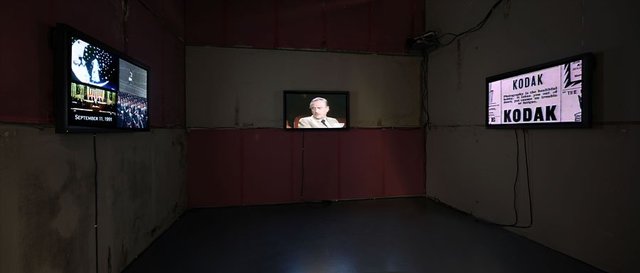Projects
Beyond the Image
A Project by Lara Baladi with an introduction by Dorothea Schoene
In the summer of 2011 and again in early 2012, I conducted interviews with Egyptian-Lebanese artist Lara Baladi. I asked her about the 2011 uprisings, the role of art within the Egyptian revolt and art as a medium of political expression in general. Due to the circumstances, however, the conversations, which took place on different occasions over the course of several months, soon became more of a diary that gave a striking impression on Baladi's activism. Months later, Baladi exhibited what could be considered her first artwork related to the revolution: Alone,…Together, in Media Res (2012), presented at group show Cairo. Open City New Testimonies from an Ongoing Revolution (28 September–23 December 2012), at the Museum for Photography in Braunschweig, Germany. The work is a constructed narrative told via excerpts from YouTube videos presented in a three-channel video installation.
As the protests reached Tahrir in January 2011, the artist began to produce and collect videos, film footage and various other materials on issues related to the events. Baladi's primary source of visual documentation was the Internet as, out of choice, she did not own a television. Throughout the very first days of the uprising, while searching for news on the protests, she came across one of the first viral videos - a film shot with a mobile phone called 'Tiananmen-Cairo' - in which a young man stands purposefully in front of a police water canon to stop it from going further. The strong symbolic gestures and iconography in the video successfully paralleled two major uprisings of the last few decades.[1] This became the starting point in building an archive initially as a response to a need to keep track of the rapidly changing situation. But subsequently, Baladi would come to pursue this search with an increasingly conscious and methodological approach.
Connecting with social media became necessary to hear about and contribute to the news being shared online from the Egyptian uprising taking place on the ground, up to the minute, day in and day out. Baladi soon built up a chronology and time line of events. Parallel to producing her own documentation, she gathered and archived articles, photographs, images of graffiti, political satire, tweets and also videos uploaded into the public domain by various citizens and media activists. This was one way the artist attempted to examine what she calls the web of'vox populi: the voice of the people. Subsequently, one of the first outcomes of Baladi's work resulted in her co-founding Tahrir Cinema.
In addition to the footage directly linked to the Egyptian revolution, Baladi soon began to gather other kinds of footage that examine and analyze what drives people to revolt: historical events, political or philosophical speeches, banned cartoons and so on. Baladi collected material ranging from Jean-Paul Sartre's speech given to workers on strike in the 1960s, Marshall McLuhan's media and communication theories and Charlie Chaplin's appearance in the movie The Dictator, to news clippings or activist statements by groups such as Greenpeace to Pussy Riot. Baladi also used parodies made by a Taiwanese activist animation team (NMATV) of the tweets sent by the Pakistani neighbor of Bin Laden on the night he was found by the American troops. In addition to these resources, the work includes products derived from other media events, some of which may seem trivial, but nevertheless point to wider issues.
For the installation in Braunschweig, Baladi chose extracts from 630 videos from her vast collection of over 2000 (and still counting). The choice of presentation is three LCD screens that encompass the viewer visually and through audio, from all sides. The setting recreates a similar sense to what most people felt during the revolution: a bombardment of neverending and rapidly changing media information. This work captures and saves sources that would otherwise have been lost for future examination. For Baladi, the piece offers the possibility to counter a flaw in the virtual world. While the Internet as an archive is a vast and rich source of information, it is also dangerously ephemeral and unstable: documents, photos or films discovered once, may be deleted the very next moment and lost forever.
Alone,…Together, in Media Res, comes at a time when skepticism towards the quality of any artwork in response to the 'Arab Spring', particularly amongst Western scholars, is still prevalent. 'It is too soon after Tahrir Square to make art: an indisputable consensus', scholar Laura U. Marks wrote just recently in a report on a discussion forum at this year's Art Dubai.[2] Admittedly, while there is a lot of work that appears to be rather immature in response to such political events, there is nevertheless a significant amount of art made in this context that deserves acknowledgement as artistic expression. For Baladi, 'this is something that is most probably not to be found in the commercial art market but rather on the ground and in new forms, which challenge 'real' audiences and in fact reject the art market of the Middle East as part of the toppled and therefore obsolete system'.[3]
By linking footage from Tahrir square with other sources and images as well as revisiting photographic and media theory, the artist attempts to 'find and define the archetypes within historical processes, which reflect the embedded quality in humans to search for freedom.'[4]
In addition, her archive is by no means in its final stages. It is an ongoing project, a work in progress and also the source for several ongoing projects - some of which are abstract and sculptural. Granted that the political circumstances in Egypt are still rapidly changing and very unstable, Baladi's approach and practice are both equally flexible, mirroring political and historical shifts as they happen.
–– Dorothea Schoene

















